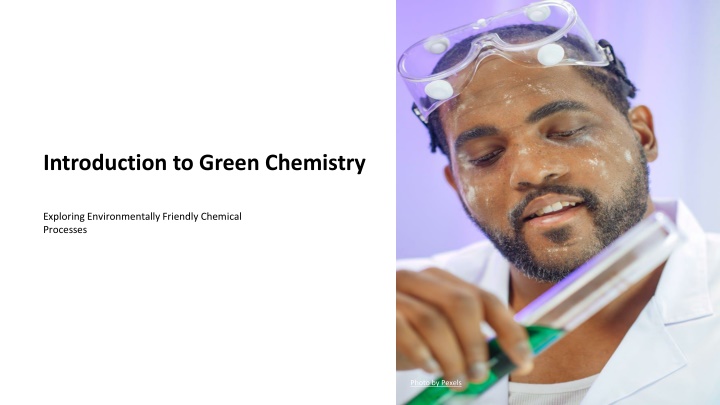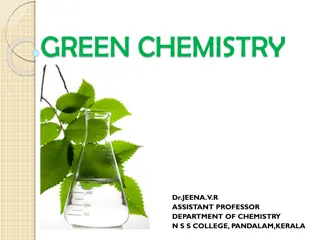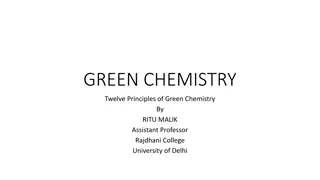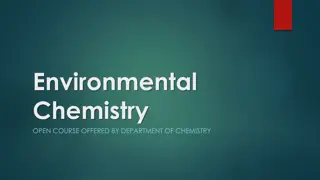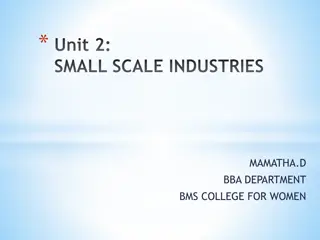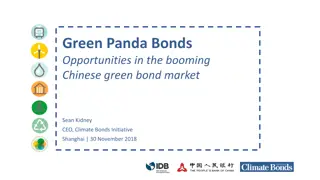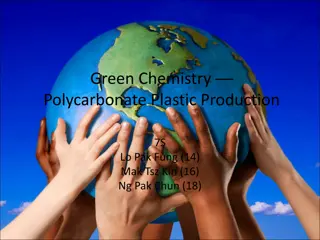Green Chemistry and the Power of AI: Transforming Industries
Explore the principles and practices of green chemistry, focusing on safe and sustainable chemical processes that prioritize environmental impact. Learn how artificial intelligence is revolutionizing industries by enhancing efficiency, accuracy, and customer experiences. Discover the synergy between green chemistry and AI in driving innovation towards a greener and more sustainable future.
Download Presentation

Please find below an Image/Link to download the presentation.
The content on the website is provided AS IS for your information and personal use only. It may not be sold, licensed, or shared on other websites without obtaining consent from the author.If you encounter any issues during the download, it is possible that the publisher has removed the file from their server.
You are allowed to download the files provided on this website for personal or commercial use, subject to the condition that they are used lawfully. All files are the property of their respective owners.
The content on the website is provided AS IS for your information and personal use only. It may not be sold, licensed, or shared on other websites without obtaining consent from the author.
E N D
Presentation Transcript
Introduction to Green Chemistry Exploring Environmentally Friendly Chemical Processes Photo by Pexels
The Power of AI Revolutionizing Industries Artificial Intelligence has transformed various industries, such as healthcare, finance, and transportation. By leveraging AI technologies, companies can improve efficiency, accuracy, and customer experience. For example, in healthcare, AI can assist in diagnosing diseases, analyzing medical images, and drug research. AI also enables personalized financial recommendations, fraud detection, and risk assessment in the finance sector. Photo by Pexels
Green Chemistry Safe and Sustainable Chemical processes that prioritize personal safety and environmental impact. Green chemistry aims to design and develop chemical processes that minimize the use of hazardous substances. By using alternative solvents and renewable raw materials, green chemistry aims to reduce pollution and waste. Examples of green chemistry include developing biodegradable plastics and implementing sustainable manufacturing practices. Photo by Pexels
The 12 Principles of Green Chemistry Guidelines for Greener Chemistry 1. Prevention: It is better to prevent waste than to treat or clean up waste after it is formed. 2. Atom Economy: Synthetic methods should be designed to maximize the incorporation of all materials used in the process into the final product. 3. Less Hazardous Chemical Syntheses: Whenever possible, synthetic methodologies should be designed to use and generate substances that possess little or no toxicity to human health and the environment. 4. Designing Safer Chemicals: Chemical products should be designed to be fully effective yet have little or no toxicity. Photo by Pexels
Waste Prevention Minimize, Reduce, Cleanup Reducing waste production is essential for minimizing the need for cleanup. By implementing waste prevention measures, we can minimize the environmental impact and save resources. One example of waste prevention is promoting recycling programs. By encouraging the recycling of materials, we can reduce the amount of waste that ends up in landfills and contribute to a more sustainable future. Another way to prevent waste is by implementing reusable packaging solutions. By opting for reusable containers instead of single-use packaging, we can significantly reduce the amount of waste generated. Waste prevention also includes minimizing food waste. By Photo by Pexels planning meals, practicing proper storage, and donating excess food, we can prevent unnecessary waste and alleviate hunger.
Using CO2 Waste Expand Polystyrene Carbon dioxide waste can be utilized to expand polystyrene packaging. Instead of releasing carbon dioxide into the atmosphere, it can be used to make polystyrene foam. This process helps in reducing the release of greenhouse gases. By utilizing CO2 waste, polystyrene packaging becomes more environmentally friendly. Photo by Pexels
Slide 7 Catchy Subtitle Paragraph 1: This is the first detailed paragraph with relevant information. Paragraph 2: This is the second detailed paragraph with relevant information. Paragraph 3: This is the third detailed paragraph with relevant information. Paragraph 4: This is the fourth detailed paragraph with relevant information. Photo by Pexels
Slide 8 Engagement Strategies One way to increase engagement is by incorporating interactive elements. Quizzes, polls, and games are effective in capturing audience attention. Another strategy is to use storytelling to connect with the audience emotionally. By sharing relatable stories, the message becomes more memorable. Photo by Pexels
Slide 9 Title Catchy Subtitle Paragraph 1: This is the first point of the slide, providing detailed information or examples relevant to the topic. Paragraph 2: This is the second point of the slide, providing detailed information or examples relevant to the topic. Paragraph 3: This is the third point of the slide, providing detailed information or examples relevant to the topic. Paragraph 4: This is the fourth point of the slide, providing detailed information or examples relevant to the topic. Photo by Pexels
Promoting Green Chemistry Reduce Impact, Improve Safety Green chemistry practices help minimize the environmental impact of chemical processes. By using renewable resources and reducing waste and pollution, green chemistry promotes sustainability. It also improves safety by designing chemical processes that are inherently safer and reducing the use of hazardous substances. Examples of green chemistry include using catalysts, developing bio-based solvents, and designing more efficient reactions. Photo by Pexels
